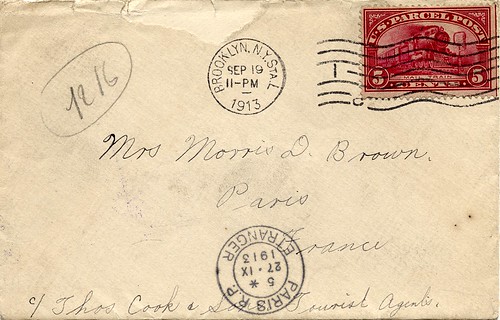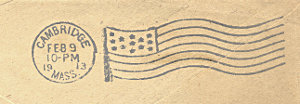U. S. Parcel Post Stamp on Cover

The United States set up the Parcel Post system in 1913, and issued special stamps for this new parcel mail. On July 1, 1913, these stamps became legal to use on first class letters, as well as for any postal payment. I've noticed that, by 1914, first class usages seem to be fewer. After 1914, Parcel Post usages are quite uncommon.
I like these stamps a great deal. They are among the first U. S. stamps to be engraved from photographic images of real situations, not just portraits of famous people. The images are very pictorial. For instance, the 20 cent stamp from this set is the first stamp issued in the world to depict an airplane.
For more information on these stamps and the service, take a look at an excellent website with Parcel Post stamp images.
View my Google photos album of Parcel Post stamp images.
Also, the late Henry Gobie wrote an excellent book on the history of the service and these stamps, published in 1979. (Because it is many years out of print, it is most likely that you will find it on used book websites, or you may also want to check for copies on eBay.)"
More information on these subjects is available on the Stamps and Postal History Pages.
CLICK ON THE THUMBNAIL IMAGES TO VIEW A LARGER IMAGE
![[Parcel Post Stamp Used in First World War Era ]](http://swansonphotos.com/pics/q/wwi_custer.jpg)
![[Parcel Post Stamp Used as Intended]](http://swansonphotos.com/pics/parcel_post_usage2.jpg)
![[Parcel Post Stamp Unsealed Usage]](http://swansonphotos.com/pics/parcel_post_usage.jpg)

![[Correct Usage for a Parcel Post Stamp]](http://swansonphotos.com/pics/pp_usage3a.jpg)
![[-Merchandise- Usage of Parcel Post Stamp]](http://swansonphotos.com/pics/pp_usage4.jpg)
![[Early First Class Usage of Parcel Post Stamp]](http://swansonphotos.com/pics/first_class_july3.jpg)
![[Dollar Parcel Post Stamp on Parcel Tag]](http://swansonphotos.com/pics/dollar_q.jpg)
![[Parcel Post Stamp As It MIGHT Have Been]](http://swansonphotos.com/pics/q/q_1cent_fantasy.jpg)